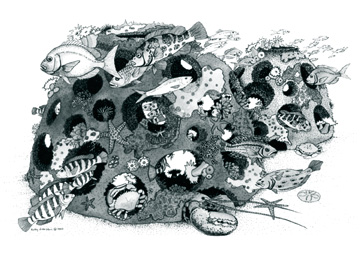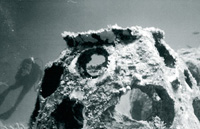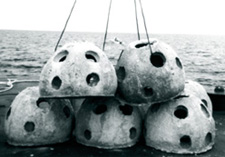|
In Sarasota Bay, Florida, the Sarasota Bay National Estuary
Program (SBNEP) has identified five major problems: stormwater,
wastewater, fisheries, recreation, and habitat loss. The 1995
Comprehensive Conservation and Management Plan (CCMP) cites nutrient
loading, metal contamination, wetland loss and loss of submerged
aquatic vegetation as major concerns. Nutrient loading of Sarasota
Bay in 1988 was approximately 400% greater than expected from a
pristine undeveloped watershed, while metal contamination was
significant. Since the 1950s, approximately 4,700 acres of bottom
habitat in Sarasota Bay have been lost due to dredging and other
activities, and 39% of tidal wetlands and 30% of the seagrass
coverage has been lost. The CCMP also called for public education,
Bay management, and further technical studies.

To restore subtidal habitat, the SBNEP has embarked on a program
to construct artificial reefs. Such reefs provide valuable habitat
for fish and other marine organisms, enhance recreational and
commercial fisheries, and help to increase public awareness
regarding natural resources in Sarasota Bay.
 A Fishery Habitat Enhancement Task
Force determined the best sites for artificial reefs in Sarasota Bay
and the best methods and materials to use. This interagency project
involves Manatee County, Sarasota County, the Southwest Florida
Water Management District, the Manasota Basin Board, and the SBNEP.
Artificial reefs were permitted in upper Sarasota Bay and northeast
of Anna Maria Island. Over the past 6 years, over 2,000 reef
structures have been placed by the SBNEP and other
organizations. A Fishery Habitat Enhancement Task
Force determined the best sites for artificial reefs in Sarasota Bay
and the best methods and materials to use. This interagency project
involves Manatee County, Sarasota County, the Southwest Florida
Water Management District, the Manasota Basin Board, and the SBNEP.
Artificial reefs were permitted in upper Sarasota Bay and northeast
of Anna Maria Island. Over the past 6 years, over 2,000 reef
structures have been placed by the SBNEP and other
organizations.
Volunteer and educational organizations have also helped to
install reef balls to restore reef habitat and raise awareness of
Sarasota Bay. Reef balls have been used elsewhere in Florida to
create artificial reefs (see Coastlines February 2000). The "Bay
Balls" are concrete reef modules approximately 3 feet across and 2
feet high and weigh about 400 lbs. Other reef balls were modified by
adding a ledge habitat to attract and support gag grouper.
The deployment of such reef modules provides an opportunity to do
valuable research on restoring the Bay bottom. Although researchers
have studied the effectiveness of artificial reefs in offshore
areas, very little research has been done on the effectiveness of
nearshore artificial reefs. The SBNEP and its partners placed reef
modules in clusters of various sizes and is monitoring these to
determine optimum size and grouping of modules. The large number of
reef modules will enable SBNEP to gather statistically significant
data on effectiveness of reef restoration using reef balls.
During 2002, the SBNEP surveyed several established artificial
reefs in Sarasota Bay. Over 25 fish and invertebrate species were
identified, including gray snapper, gag grouper, sheepshead and
stone crab. Although fish were abundant in the vicinity of the reefs
(as attested by local fishermen), species diversity was low. A
variety of artificial reef types would probably be needed to
increase species diversity.
 The SBNEP is also studying artificial
structures that would provide juvenile fish nursery habitat. An
early pilot project showed the potential value of deploying
artificial reefs along hardened seawalls (e.g., seawalls and
rip-rap); some types of structures had fish aggregations more than
100 times that of nearby areas that had no artificial reefs. In a
recent shoreline survey, researchers found that over 200 miles of
armored and altered shoreline exist. Altered shorelines typically do
not provide enough complex or suitable habitat for fish. The SBNEP is also studying artificial
structures that would provide juvenile fish nursery habitat. An
early pilot project showed the potential value of deploying
artificial reefs along hardened seawalls (e.g., seawalls and
rip-rap); some types of structures had fish aggregations more than
100 times that of nearby areas that had no artificial reefs. In a
recent shoreline survey, researchers found that over 200 miles of
armored and altered shoreline exist. Altered shorelines typically do
not provide enough complex or suitable habitat for fish.
The SBNEP and its partners are working to enhance habitat along
altered shorelines by installing artificial reefs along shorelines
and under docks (where feasible and permittable). Some reef modules
may be provided to neighborhoods or municipalities through grants
for reef placement along privately owned waterfront. Researchers
will also study the value of using reef modules to restore the
intertidal zone and to grow oyster beds. The SBNEP is working on
obtaining "blanket" permits for neighborhoods and municipalities, to
facilitate restoration.
 Different types of artificial reef
structures will be evaluated for their ability to provide fish
habitat, cost effectiveness, and feasibility of deployment. They
will be monitored to see how effective they are in increasing
numbers of fish and biodiversity, whether they attract fish from
other nearby areas, and whether the reefs are promoting survival of
juvenile fish. The SBNEP hopes to restore reef habitat throughout
the Bay, by partnering with private individuals, organizations, and
government agencies. By fostering research and education and
involvement by local diving groups, the SBNEP hopes to raise public
awareness of the value of a restored Bay. Different types of artificial reef
structures will be evaluated for their ability to provide fish
habitat, cost effectiveness, and feasibility of deployment. They
will be monitored to see how effective they are in increasing
numbers of fish and biodiversity, whether they attract fish from
other nearby areas, and whether the reefs are promoting survival of
juvenile fish. The SBNEP hopes to restore reef habitat throughout
the Bay, by partnering with private individuals, organizations, and
government agencies. By fostering research and education and
involvement by local diving groups, the SBNEP hopes to raise public
awareness of the value of a restored Bay.
For further information, contact Gary E. Raulerson, Senior
Environmental Scientist, Sarasota Bay National Estuary Program, 5333
N. Tamiami Trail, Suite 104, Sarasota, FL 34234; Phone:
941-359-5841; Fax: 941-359-5846; Email: Gary_Raulerson@ci.sarasota.fl.us;
Website: http://www.sarasotabay.org/
 |
|

